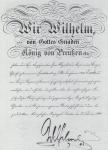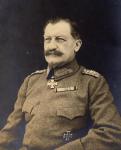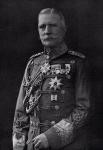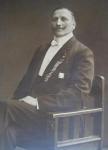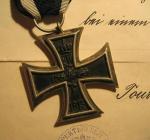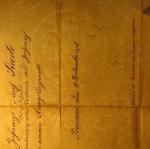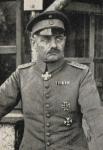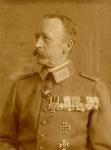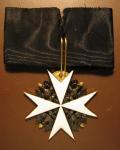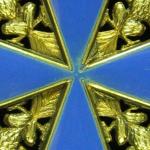-
Posts
1,291 -
Joined
-
Last visited
-
Days Won
20
Content Type
Profiles
Forums
Blogs
Gallery
Events
Store
Everything posted by Komtur
-
Hello Ulsterman, that ribbon-question in this case is quite difficult. In the statuts of the Honor Decoration for the XXV anniversery it is spoken of orders, not decorations. Therefore I am shure, that very rare example with that special ribbon you mentioned is representing a Crown Order (4th or 3rd class) with memory ribbon ("am Erinnerungsband") awarded 1870/71 for merits behind the front. This "Erinnerungsband" is the same later used for the war merit cross. With regards, Komtur.
-

EK 1914 EK II 1914 with document for a dentist
Komtur replied to Komtur's topic in Germany: All Eras: The Iron Cross
I?ve got only the EK II with the dokument, no other decorations or papers - so I don?t know. Komtur. -

EK 1914 EK II 1914 with document for a dentist
Komtur replied to Komtur's topic in Germany: All Eras: The Iron Cross
Sorry, but I?m afraid my English or my knolwedge of the EK is not sophisticated enough to understand what you mean -
Hello Humberto, this questions were discussed a few weeks ago in the similar German forum "Sammlergemeinschaft Deutscher Auszeichnungen": It was awarded to persons close to the jubilee couple, so it was not a common award. It was given also to 119 veterans belonging 25 years before to the 2nd company of the 1st Garde-Regiment zu Fu?, because that company was led by prince Wilhelm, the later Kaiser Wilhelm II. The figure XXV with a myrtle wreath around in silver lays on the ribbon of the last awarded Prussion order. If the person got no Prussion order before, the ribbon was white. The 119 veterans got the award on the ribbon of the Allgemeines Ehrenzeichen (see picture below). The awarding document was signed personally by the Kaiser. with regards, Komtur.
-

EK 1914 EK II 1914 with document for a dentist
Komtur replied to Komtur's topic in Germany: All Eras: The Iron Cross
At last the Iron Cross, that comes with this awarding document is a fine example. There are no marks on it. With regards, Komtur. -

EK 1914 EK II 1914 with document for a dentist
Komtur replied to Komtur's topic in Germany: All Eras: The Iron Cross
-

EK 1914 EK II 1914 with document for a dentist
Komtur posted a topic in Germany: All Eras: The Iron Cross
This awarding document for an Iron Cross 2nd class 1914 is in my opinion interesting in some points. At first it is given to a dentist. This "rank" is not often to be seen on these documents. I would like to know, what kind of heroic action was the reason for this award. May be he kills the pain of his commander . I like the plain design of this paper. -
With this order it is a difficult thing, even if I try to explain it in my own language . But I will try to give some facts from "Preu?ischer Ordensherold" by Hoeftmann in 1868: The order was founded in 1812 as a memory to the "Balley Brandenburg des Johanniter-Ordens". This Brandenburg part of the former catholic Johanniter-Orden was dissolved in 1810 by the Prussian king Friedrich Wilhelm III. and the property was confiscated by the prussian state. The former member of the order were allowed to ask for admission to the new Prussian order. It seem to be until 1853 for the new members a kind of order for merits ("... Personen, welche sich um Uns, um Unser K?nigliches Haus, und um Unsere Monarchie verdient gemacht haben ..."). In 1853 the Prussian king Friedrich Wilhelm IV. refounded the "Balley Brandenburg" of the Johanniter-Orden as an protestant organization for public benefit. Besides the determination of the orders structure, there were two main changes in the "Statuten" of 1853. At first the Prussian nobleman, who became a knight of this order had to pay for it: as "Ehrenritter" with a yearly charge of 12 Reichsthaler, as "Rechtsritter" with an admission charge of 100 Reichsthaler. At second a nobleman could ask for admission as "Ehrenritter" than he had to pay a charge of 300 Reichsthaler. The money was used to found hospitals and similar institutions and the knights of the order had to organize this. So there seem to be a change from an order of merit to a kind of public welfare organization. A Prussian nobleman could show with wearing this order 1. I am a nobleman 2. I have the money to be a member of this club 3. I give some money for public benefit or/and be active in a public welfare organization. When I see pictures of officers with this order, I?ve got the feeling it is not annoying for some of them, that there is a similarity to the highest Prussian order for military merit With regards, Komtur. Today the postman came with this : Bronze gilt Ehrenritter in poor quality, but I got it on ebay more by chance for about 160 Euro... Can?t say when it was produced, but it is certain no copy, cause it is worn and I believe there is no market for copies of a bronze gilt Johanniter Ehrenritter
-
Very interesting gentlemen! Unfortunately I?ve read the above mentioned thread for the first time (please be indulgent with me, I?m here only for a few month). After that I?m with Les now, that there is a possibility, that the shown cross could be from a Wagner or Friedl?nder die and not very late after 1918. As I understood, the picture of the reverse and of the eagles of the discussed cross above is the clue? On the other hand, what do you think Les, of the detailed reverse picture of a PlM awarded in June 1918 (as far, as I know) - is this the second part of the answer? With regards, Komtur. Reverse of a June 1918 awarded Friedl?nder (FR 938 marked on the lower arm):
-
I could only find an early gold Godet cross about 1880 (Royal collection, London). The quality of the picture is not as good, as the above showed, but I think, the difference is to be seen. I can only recommend the book Prussian Blue of Stephen Previtera with lots of detailed fotos and a convincing interpretation of the crosses you can find on the marked. But what is your cross? I would judge it as "after 1918". If one have a so called "Zweitst?ck" of the twenties or a later production for collectors is often quite hard to distinguish. With regards, Komtur.
-
Hallo Mike, in my humble opinion this is not an official issued cross. The silver gilded PlM of late WW1 are made by Wagner, Friedl?nder and Godet. The Wagner and Friedl?nder crosses are very similar, but different to yours. Compare the two late WW1 PlM (Wagner left, Friedl?nder right) with the eagles on your cross. I would say it is not only a difference in style, also in quality. (I will search now for a usefull picture of a Godet cross)



